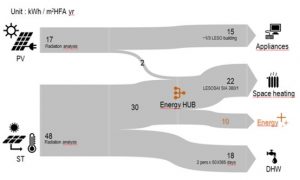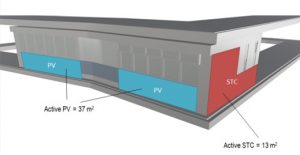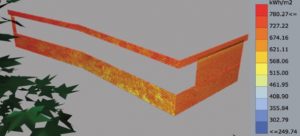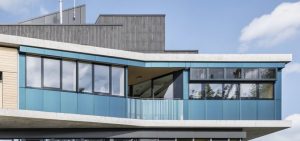The building integration of our novel technologies are studied in the SolAce unit of the NEST demonstration platform on EMPA campus in Dübendorf: multi-functional facade technologies are implemented to achieve an Energy-Plus and Low Carbon combined working/living space. The unit SolAce @ NEST features the following technologies which have been developed in A. Schüler’s research group: light redirecting optical microstructures, laser-treated selective glazing, and colored glazing for PV & solar thermal collectors.
In order to enhance social acceptability of solar energy in cities [FLO2018], the building integration of our novel technologies is studied in the SolAce unit of the NEST demonstration platform on EMPA campus in Dübendorf: our multi-functional facade technologies are implemented to achieve an Energy-Plus and Low Carbon combined working/living space [FLO2022] (see Fig. 1).
Among the multi-functional technologies installed on the SolAce facades, colored nanotechnology-based glazing for PV modules and solar thermal collectors lead to a positive energy balance over the whole year for the unit through the production of solar electricity and domestic hot water. Innovative window integrated micro-structured glazing provide seasonal dynamic management of solar heat gains. On the demand side, combining working and living spaces in order to mitigate the treated floor area for indoor activities reduces significantly the heating and lighting energy intensities of the unit as well as its environmental impact. Made of prefabricated modular wooden elements and mostly equipped with cardboard-made furniture, the SolAce architectural design is also aiming to foster building materials with low embodied energy and carbon content.
The unit SolAce @ NEST features the following technologies which have been developed in A. Schüler’s research group:
· Light redirecting optical microstructures
A novel glazing type with embedded micro mirrors that are invisible to the eyes is to be used to increase the daylight provision in a room through redirection of sunlight to the ceiling. The redirection of daylight provides a more uniform work plane illuminance and reduces glare risks. Moreover, solar gains are modulated as a function of the annual dynamic variation of the sun course: high gains in winter reduce heating loads and low gains in summer mitigate overheating risks as well as the cooling demand.
· Laser-treated selective glazing
This novel glazing was developed to foster mobile telecommunication in railway wagons: it can also be implemented on building envelopes and/or inside buildings. The glazing provides a high thermal insulation by means of a selective coating (e.g. e-coating) and is accordingly suitable for application in hot and cold climates. The laser-treated glass panes can be cut to measure and assembled for multiple glazing with the desired dimensions. The glazing is compatible with all common standard supports and can therefore be easily installed by glazing professionals.
· Colored glazing for PV & solar thermal collectors
Coloured glazing for PV modules and solar thermal collectors is based on nanometric multilayered thin films that are produced by environmentally friendly plasma-driven physical vapour deposition. The innovative coatings do not need absorbing pigments for the coloration and are optimized for solar electricity and domestic hot water production. This technology offers new opportunities combining full design flexibility and aesthetics with optimal energy performance for building integration of active solar energy systems.
Internet link NEST/SolAce:
https://www.empa.ch/web/nest/solace
References
[FLO2022] Florio, P., Tendon, X., Fleury, J., Costantini C. , Schueler A., Scartezzini J.-L., Performance Assessment of a nZEB Carbon Neutral Living/Office Space and Its Integration into a District Energy-Hub, Energies 2022, 15(3), 793 https://doi.org/10.3390/en15030793
[FLO2018] Florio, P., Munari Probst, M.C., Schüler, A., Roecker, C., Scartezzini, J.-L., Assessing visibility in multi-scale urban planning: A contribution to a method enhancing social acceptability of solar energy in cities, (2018) Solar Energy, 173, pp. 97-109
https://doi.org/10.1016/j.solener.2018.07.059
a)
b)
c)
d) 
Fig. 1: SolAce unit of the NEST demonstration platform on EMPA campus in Dübendorf: multi-functional facade technologies are implemented to achieve an Energy-Plus and Low Carbon combined working/living space [FLO2022].
a) Sankey diagram of the energy concept. The solar energy harvested on the façade by both the photovoltaic modules and the solar thermal collectors covers the energy demand of the building unit. An additional energy of approx. 10 kWh per m2of heated floor area a year is expected. The building will be monitored in order to confirm the theoretical projections.
b) The south-west façade is equipped with 37 m2of photovoltaic modules and 13 m2of solar thermal collector. Both photovoltaic modules and solar thermal collectors are based on the solar glazing technology Kromatix developed in our group.
c) Analysis of the incident solar radiation on the vertical south-west end south east façades.
d) The unit was inaugurated in 2018. Besides the novel photovoltaic and solar thermal technologies, the façade features the novel microstructured glazing for improved daylight management, as well as the novel insulating glazing which is transparent for the microwaves of mobile communication.